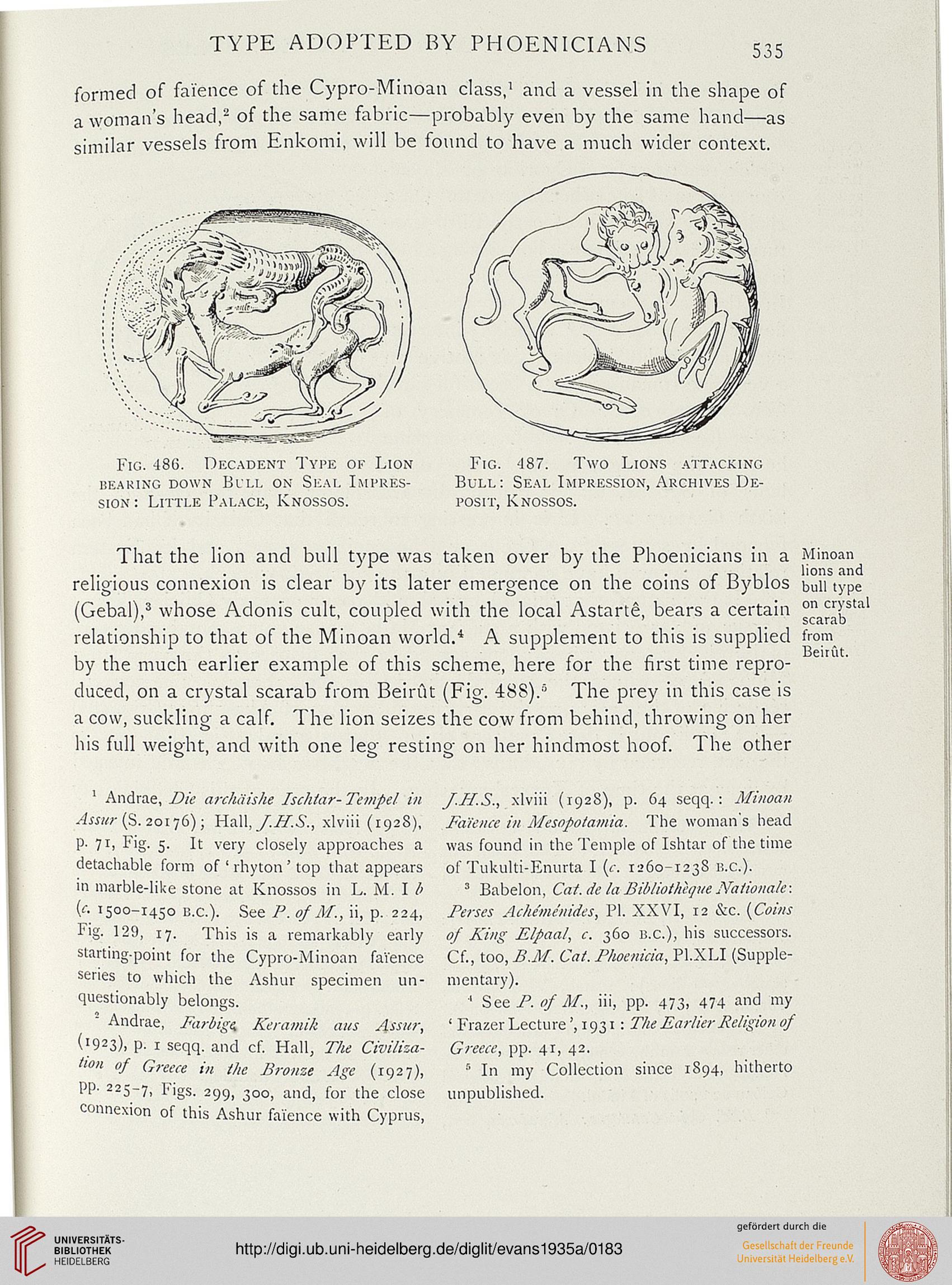TYPE ADOPTED BY PHOENICIANS 535
formed of faience of the Cypro-Minoan class,1 and a vessel in the shape of
a woman's head,2 of the same fabric—probably even by the same hand—as
similar vessels from Enkomi, will be found to have a much wider context.
c. 486. Decadent Type of Lion
ing down Bull on Seal Impres-
: Little Palace, Knossos.
Fig. 487. Two Lions attacking
Bull: Seal Impression, Archives De-
posit, Knossos.
That the lion and bull type was taken over by the Phoenicians in a Minoan
religious connexion is clear by its later emergence on the coins of Byblos bull type
(Gebal),3 whose Adonis cult, coupled with the local Astarte, bears a certain ""j^"1'
relationship to that of the Minoan world.'1 A supplement to this is supplied from
by the much earlier example of this scheme, here for the first time repro-
duced, on a crystal scarab from Beirut (Fig. 48S).5 The prey in this case is
a cow, suckling a calf. The lion seizes the cow from behind, throwing on her
his full weight, and with one leg resting- on her hindmost hoof. The other
1 Andrae, Die arcMishe Ischtar- Tempel. in
Assur (S. 20176); Hall, J.H.S., xlviii (1928),
p. 71, Big. 5. It very closely approaches a
detachable form of ' rhyton' top that appears
in marble-like stone at Knossos in L. M. I b
(c. 1500-1450 B.C.). See P. of M., ii, p. 224,
lug. 129, 17. This is a remarkably early
starting-point for the Cypro-Minoan faience
series to which the Ashur specimen un-
questionably belongs.
* Andrae, Farbige, Keramik cms Assur,
U923), P- 1 seqq. and cf. Hall, The Civiliza-
tion of Greece in the Bronze Age (192 7),
pp. 225-7, Figs. 299, 300, and, for the close
connexion of this Ashur faience with Cyprus,
/■U.S., xlviii (1928), p. 64 seqq.: Minoan
Faience in Mesopotamia, q'he woman's bead
was found in the Temple of Ishtar of the time
of Tukulti-Enurta I (c. 1260-123S B.C.).
3 Babelon, Cat.de la BibliothhpieNationalc:
Perses Ache'me'nides, PI. XXVI, 12 &c. (Coins
of King Flpaal, c. 360 B.C.), his successors.
Cf., too, P.M. Cat. Phoenicia, Pl.XLI (Supple-
mentary).
' See P. of M., iii, pp. 473, 474 and my
'Frazer Lecture', 1931: The Earlier Religion of
Greece, pp. 41, 42.
' In my Collection since 1S94, hitherto
unpublished.
formed of faience of the Cypro-Minoan class,1 and a vessel in the shape of
a woman's head,2 of the same fabric—probably even by the same hand—as
similar vessels from Enkomi, will be found to have a much wider context.
c. 486. Decadent Type of Lion
ing down Bull on Seal Impres-
: Little Palace, Knossos.
Fig. 487. Two Lions attacking
Bull: Seal Impression, Archives De-
posit, Knossos.
That the lion and bull type was taken over by the Phoenicians in a Minoan
religious connexion is clear by its later emergence on the coins of Byblos bull type
(Gebal),3 whose Adonis cult, coupled with the local Astarte, bears a certain ""j^"1'
relationship to that of the Minoan world.'1 A supplement to this is supplied from
by the much earlier example of this scheme, here for the first time repro-
duced, on a crystal scarab from Beirut (Fig. 48S).5 The prey in this case is
a cow, suckling a calf. The lion seizes the cow from behind, throwing on her
his full weight, and with one leg resting- on her hindmost hoof. The other
1 Andrae, Die arcMishe Ischtar- Tempel. in
Assur (S. 20176); Hall, J.H.S., xlviii (1928),
p. 71, Big. 5. It very closely approaches a
detachable form of ' rhyton' top that appears
in marble-like stone at Knossos in L. M. I b
(c. 1500-1450 B.C.). See P. of M., ii, p. 224,
lug. 129, 17. This is a remarkably early
starting-point for the Cypro-Minoan faience
series to which the Ashur specimen un-
questionably belongs.
* Andrae, Farbige, Keramik cms Assur,
U923), P- 1 seqq. and cf. Hall, The Civiliza-
tion of Greece in the Bronze Age (192 7),
pp. 225-7, Figs. 299, 300, and, for the close
connexion of this Ashur faience with Cyprus,
/■U.S., xlviii (1928), p. 64 seqq.: Minoan
Faience in Mesopotamia, q'he woman's bead
was found in the Temple of Ishtar of the time
of Tukulti-Enurta I (c. 1260-123S B.C.).
3 Babelon, Cat.de la BibliothhpieNationalc:
Perses Ache'me'nides, PI. XXVI, 12 &c. (Coins
of King Flpaal, c. 360 B.C.), his successors.
Cf., too, P.M. Cat. Phoenicia, Pl.XLI (Supple-
mentary).
' See P. of M., iii, pp. 473, 474 and my
'Frazer Lecture', 1931: The Earlier Religion of
Greece, pp. 41, 42.
' In my Collection since 1S94, hitherto
unpublished.





